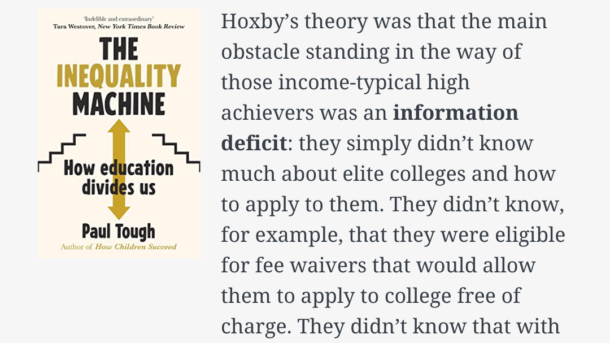In contrast to that small, ambitious group, the majority of high-scoring low-income students had aspirations that seemed much more constrained. They followed the same pattern as lower-scoring low-income students, applying to only one or two institutions, often including a local community college or a nearby nonselective public university. Most didn’t apply to a single selective college. Hoxby and Avery referred to members of this cohort as “income-typical” students, their college decisions defined by their socioeconomic status and not by their academic ability. Compared to their achievement-typical peers, these students were more likely to live in small towns or rural areas in the middle of the country and to attend schools where they would be one of only a few high-achieving students. They were also significantly more likely to be white: 80 percent of them, in fact, were white, compared to just 45 percent of the achievement-typical low-income students. Hoxby’s theory was that the main obstacle standing in the way of those income-typical high achievers was an information deficit: they simply didn’t know much about elite colleges and how to apply to them. They didn’t know, for example, that they were eligible for fee waivers that would allow them to apply to college free of charge. They didn’t know that with test scores as high as theirs, they would likely be admitted to selective colleges. They didn’t know that if admitted, they would likely get lots of financial aid—so much aid, in fact, that it might actually be cheaper for them to attend an excellent private college halfway across the country than to go to the decent public university nearby. And they didn’t know these significant facts, Hoxby hypothesized, because there was no one around to tell them. No one from their family or their high school—or maybe even their entire town—had ever attended a selective out-of-state college. And institutions like Harvard weren’t telling them this story either, at least not in an up-close and personal way. Elite colleges almost never sent recruiters to the high schools attended by these income-typical students, in part because the schools were usually in the middle of nowhere.
Income is 1 factor. But that other really noticeable factor is about “information deficit“. Generally, the environment we grows up in usually determines the opportunities that we are exposed to. A child born in a middle income family but with parents who have knowledge of how to maximise the opportunities for their child. Perhaps one best such instance for this can be the movie “King Richard”, which is about the story of how Richard, father of the Serena and Venus Williams, tried his utmost best to ensure that his kids would become stars.
Parents play a super huge role, positive or negative, in maximising the opportunities of their children after all. That is where I think that more effort can be done systematically to bridge that information deficit. In another passage of this book, Tough talks a lot about how a super disproportionate sum of money are going to kids whom already have access to greater opportunities. Ideally, most funding and resources should be dedicated towards bridging and counselling, ensuring that every kid gets the advice that they need to further optimize their career choices or outcomes.
So how much is too much intervention? And how much should the state interfere in every family’s parenting? A lot of that is down to your own personal beliefs and values of how much the government should intervene. For me, I think that resources definitely can and should be put towards bridging the gap and ensuring that everyone is able to achieve their potential, and not just dedicating resources over-proportionately towards the ones whom already have the best opportunities.



